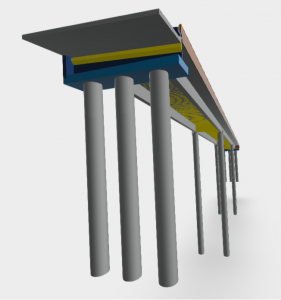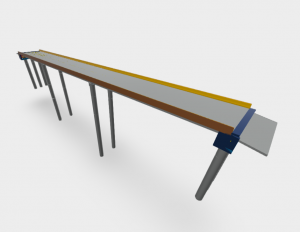PUENTE EN EL AFLUENTE SINIFANÁ CALZADA DERECHA (Puente 10A)

| Kategorie | Projekty infrastruktury |
|---|---|
| Rok | 2018 |
| Země | Colombia |
| Organizace | Área Ingenieros Consultores SAS |
| Autor | Área Ingenieros Consultores SAS |
| Spoluautoři | Juan Pablo Murillo Urrego, Esteban Murillo Urrego |
| Klient | Gisaico SA |
| Místo stavby | COLOMBIA, ANTIOQUIA, VIA AL PACIFICO |
| Tags |
El Proyecto Autopista Conexión Pacífico 1, en Colombia, se desarrolla completamente en doble calzada y hace parte de las denominadas Autopistas para la Prosperidad. La vía objeto de la concesión Pacífico 1, tiene una longitud estimada de 32.2 kilómetros de vía nueva en doble calzada, con dos túneles (Sinifaná y Amagá) y 54 puentes. Su recorrido discurre íntegramente en el departamento de Antioquia, partiendo del Corregimiento de Bolombolo (municipio Venecia), pasando por el corregimiento de Camilo Cé (municipio de Amagá), hasta conectar en Primavera (municipio de Caldas) con los 18 km de la doble calzada existente que culmina en Ancón Sur.
En este tipo de puentes, la superestructura o tablero es sustentada por vigas. Debido a que la longitud máxima que puede alcanzar un vano con este tipo de estructuras es menor (aprox. 50m), estos puentes requieren mayor número de apoyos con respecto a los de voladizos para una misma longitud.
Existe un primer momento en que se construye la cimentación para transmitir las cargas de la estructura al terreno, posteriormente se avanza con la construcción de los caissons de cimentación que hacen las veces de columnas, una vez salen del terreno y finalmente se construye la superestructura o tablero del puente.
El puente en el afluente Sinifaná calzada derecha tiene su estribo de entrada en la abscisa K9+179.65 y su salida en la Abscisa K9+275.25 con trazado en planta recto.
El puente tiene tres (3) luces de longitudes 25.22 m, 35.15 m y 35.22 m para una longitud total de 95.59 m soportadas por estribos en los ejes extremos y por dos (2) caisson de 1.50m de diámetro en cada uno de los apoyos central.
La superestructura tiene sección transversal en doble T, conformada por dos vigas postensadas de 95 Metros en cada luz, fundidas in situ, y consideradas continuas para la condición de servicio. Dichas vigas a su vez soportan una losa central prefabricada preesforzada que junto con un hormigonado de segunda etapa conformaran la losa de 10.20 m de ancho y 0.25 m de espesor sobre la cual circulan los vehículos.
El apoyo central del eje 2 se conforma con dos caissons (izquierdo y derecho) uno bajo cada viga de la superestructura, de diámetro de 1.50 m, que tienen altura aproximada desde su parte superior hasta la superficie del terreno de 8.30 m y 11.80 m. El nivel de desplante de los caissons se realiza en la cota 752.13 m.
El apoyo central del eje 3 se conforma con dos caissons (izquierdo y derecho) uno bajo cada viga de la superestructura, de diámetro de 1.50 m, que tienen altura aproximada desde su parte más alta hasta la superficie del terreno de 3.60 m y 7.10 m. El nivel de desplante de los caissons se realiza en la cota 752.66 m.
In Colombia, the project Autopista Conexión Pacífico (Highway Pacific Connection 1), is being compeltely developed as dual carraigeway and part of the so called Autopistas para la Prosperidad.The road, subject of the concession Pacífico 1, has an estimated lenght of 32.2 kilometers of new dual carriageway road with 2 tunnels (Sinifaná and Amagá) and 54 bridges. It’s route runs completely in the department of Antioquia, starting in the town of Bolombolo (municipality of Venecia), passing the town of Camilo Cé (municipality of Amagá) until it connects in the town of Primavera (municipality of Caldas) with the other 18 kilometers of an already existing dual carriageway road that ends in Ancón Sur.
In this kind of bridges, the superstructure is supported by beams. Due to the fact that the maximum lenght that can be obtained for a span in this kind of structures is approximately 50 meters, this bridges require a higher number of sopports relative to a cantilever with the same lenght.
The foundations are first constructed to pass the loads from the structure to the soil and then the the foundation caissons are constructed, which are sometimes used as columns once they protrude from the soil. Finally, the superstructure of the bridge is constructed.
The bridge on the tributary Sinifaná, right carriageway, has its entrance acces in the abscissa K9+179.65, and its exit is in the abscissa K9+275.25 with a straight trace seen from the top view.
The bridge has three (3) spans with lenghts of 25.22 meters, 35.15 meters and 35.22 meters, for a total of 95.59 meters, supported by abutments in both extreme axis, and by two (2) caissons with 1.50 meters of diameter in each of the central support pionts.
The superstructure has a corss section in double T, formed by two post-stressed beams with spam lenghts of 95 meters, made in situ, and considered continuous fo the operational conditions. Such beams also support the central pre-fabricated prestressed slab that along with the second stage concrete pouring, will integrate the slab of 10.20 meter of width with a thickness of 0.25 meters on top of which the car circulation will occur.
The central support of the axis number 2 is made of two caissons (left and right), one under each beam of the superstructure, with diameters of 1.50 meters and with an aproximate height from its superior part to the ground surface of 8.30 meters and 11.80 meters. The [desplante] level is made at a height of 752.13 meters.
The central support of the axis number 2 is made of two caissons (left and right), one under each beam of the superstructure, with diameters of 1.50 meters and with an aproximate height from its superior part to the ground surface of 3.60 meters and 7.10 meters. The [desplante] level is made at a height of 752.66 meters.



Excelente!!!